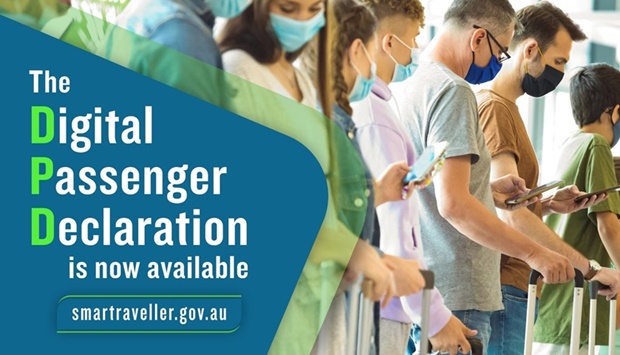Starting February 18, people travelling to Australia have a new way to provide the health information required to enter the country - the Digital Passenger Declaration (DPD).
Australian ambassador to Qatar Jonathan Muir shared the information on his Twitter page, with the details of the DPD available at https://covid19.homeaffairs.gov.au/digital-passenger-declaration
The Digital Passenger Declaration has replaced the Australia Travel Declaration.
All passengers arriving by air into Australia should complete the DPD. "You can start your DPD seven days before your flight and submit it within 72 hours prior to your departure for Australia. This is because you must provide your health information and declaration (vaccination status and Covid-19 test result) within 72 hours before your flight," the DPD webpage states.
When filling out the DPD, one will need to:
1. Provide the contact details, including a contact phone number in Australia
2. Make a legally binding declaration in relation to one's vaccination status
3. Make a declaration regarding one's last 14 days' travel history
4. Make a declaration that one is aware of the quarantine and testing requirements that apply when coming to Australia and in the state or territory one is landing, and the penalties for non-compliance.
The Digital Passenger Declaration requests critical health information. "You must be able to provide evidence that the critical information was completed before boarding the aircraft. This is an enforceable requirement. A person who fails to comply with the requirement may be liable to a civil penalty (fine) of 30 penalty units (currently 6,660 AUD). This is set out in section 46 of the Biosecurity Act 2015," the webpage explains.
Giving false or misleading information to the Australian government is a serious offence. If convicted, the maximum penalty is imprisonment for 12 months.
States and territories may also apply penalties in order to enforce compliance with public health orders. This may include Covid-19 testing and self-isolation or quarantine requirements. "If you do not comply with requirements including pre-departure and post-arrival testing, you may face serious penalties, including jail time or significant fines. Requirements may change at short notice," the webpage adds.
One can complete the DPD at https://dpd.homeaffairs.gov.au/
One will need to create an account, which will allow the person to manage current and future declarations in one place.
"Ensure you have completed the health section and provide all critical health information within 72 hours before your departure. Providing this information is an enforceable requirement. It will help ensure you don’t experience unnecessary delays at the airport, or when you arrive in Australia," the webpage notes.
One does not have to pay for the DPD — it is free.
Before starting the declaration, one should have the below information ready:
1. flight number
2. valid passport
3. travel history (14 days before the flight)
4. destination and quarantine arrangements (if required)
5. Covid-19 vaccination record or acceptable proof you cannot be vaccinated for medical reasons
You will also need to provide a negative Covid-19 Polymerase Chain Reaction (PCR) test or other nucleic acid amplification test result within three days of the flight’s scheduled departure to Australia, or a medical certificate as evidence of a negative Rapid Antigen Test (RAT) taken under medical supervision within 24 hours before the flight’s scheduled departure to Australia. You can upload this by logging back into your DPD account when you have the test result.
Each passenger is required to complete a DPD. Parents or guardians should complete a declaration for any child under 16 years of age. Anyone who is 16 years old or over should complete their own declaration.
A completed Digital Passenger Declaration does not guarantee travel to Australia.
Once you have submitted the Digital Passenger Declaration, you will see a summary screen that you must show (either electronically or printed) before you board your flight and on arrival in Australia.
Check-in staff will review your health status, it will either show:
1. Complete: the information you have entered in your declaration indicates you meet Covid-19 health requirements for boarding. You will still need to show your documentation at check-in. Your airline will make the final decision to let you board your flight.
2. Incomplete: you have not submitted your health information. The Digital Passenger Declaration requests critical health information. You must be able to show evidence that you completed the critical information before boarding.
3. Confirmation required at check-in: this means you may not have met the requirements for travel to Australia. You need to be confirmed at check-in. Your airline will decide if you can travel. If the airline allows you to travel to Australia, you may need to quarantine on arrival. Before you start your DPD you should check the Department of Health website (https://www.health.gov.au/health-alerts/covid-19/international-travel/inbound). This has details on the important health rules passengers need to follow when coming to Australia.
All passengers should check the arrangements in both their place of arrival and place of final destination, as quarantine requirements (https://www.health.gov.au/health-alerts/covid-19/international-travel) are different in each Australian state and territory.
If you need help completing your Digital Passenger Declaration, visit the frequently asked questions page at https://immi.homeaffairs.gov.au/help-text/dpd/Pages/faq-english.aspx

